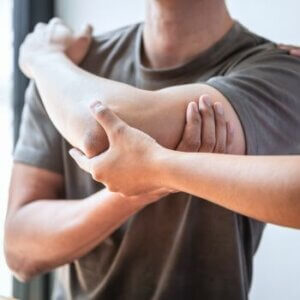Welcome to Park Avenue Physical Therapy, where compassionate care meets customized solutions on your journey to optimal physical well-being. Our Huntington Station physical therapy services are designed to empower you to regain and enhance your mobility, strength, and overall functionality. At Park Avenue Physical Therapy, we understand that each individual is unique, and so are their needs. Our team of highly skilled and dedicated physical therapists is committed to providing personalized and evidence-based interventions to address a wide range of musculoskeletal conditions and injuries. Whether you’re recovering from surgery, managing chronic pain, or seeking performance optimization, our goal is to guide you toward a healthier, more active lifestyle. Explore the possibilities of renewed vitality with Park Avenue Physical Therapy – where your path to recovery begins.
Huntington Station Physical Therapy

Sprains, Strains and Ankle Pain! What You Need to Know and When to See a Therapist
It’s an all-too-common scenario: You trip over a clod of turf or get knocked down in a game, only to find that your ankle no longer bears your weight when you try to stand up again. Ankle sprains and strains affect joggers, sprinters, football players, and almost any other type of athletes you can name. But ankle pain can also occur due to other, more slow-growing causes — and these problems can prove just as debilitating when mobility is an important part of your performance. This blog will help you get to gain a better understanding of ankle conditions and why you should contact a Park Avenue Physical Therapy physical therapist today for advice and assistance.
 Strains, Sprains, and Other Causes of Ankle Pain
Strains, Sprains, and Other Causes of Ankle Pain
The structure we call the ankle is a surprisingly complex assembly of bones, muscles, tendons, ligaments, muscles, and nerves. It doesn’t simply tilt upward and downward, like a hinge; it’s also capable of turning inward and outward to some degree. Whenever any condition or trauma impairs this structure’s ability to support and articulate the ankle, ankle pain is likely to plague you as an unfortunate side effect.
Two of the most common acute ankle injuries are strains and sprains. A strain occurs when a muscle or tendon is stretched or torn. A sprain is the same kind of damage, occurring in a ligament. Either injury can cause intense pain and swelling and reduced range of motion. Strains may also cause muscle spasms, while sprains are more likely to produce visible bruising. (If you heard an audible popping or clicking noise when you hurt your ankle, you’re looking at a sprain.)
But sprains and strains aren’t only ankle afflictions that can hobble an athlete. An ankle fracture can be even more debilitating than either of these injuries, requiring extensive immobilization in a cast or walking boot. Chronic ankle pain may be caused by arthritis, gout (a form of arthritis that often affects the foot), tarsal tunnel syndrome (a form of nerve impingement caused by surrounding tissue inflammation), and bursitis (inflammation of the cushioning structures in the ankle joint).
How Physical Therapy Can Get Your Ankle Back in Order
An acute ankle injury requires the immediate attention of your family doctor or an emergency room. X-rays can usually determine whether you have a fracture. If you have a strain or sprain, you’ll need to apply first aid in the form of a protocol known as R.I.C.E — rest, ice, compression, and elevation. Anti-inflammatory medications can also help you reduce some of the pain and swelling. Other forms of treatment such as chiropractic adjustment or physical therapy will have to wait until the initial trauma has subsided.
If you’re suffering from a milder injury or chronic ankle condition, you may be able to proceed with physical therapy right away. Depending on your condition, goals, and symptoms, our physical therapist may prescribe non-weight-bearing physical therapy exercises such as:
- Plantar flexion.
- Inversion/eversion (pointing the feet toward the left or right).
- “Drawing” the letters of the alphabet with your toes.
- Gentle isometric exercises to build ankle muscle strength.
- Resistance training with a TheraBand looped around the foot.
Our physical therapy team may supplement these exercises with soothing physical therapy techniques such as massage therapy, heat, ice, or ultrasound therapy.
Contact Our Physical Therapist for Ankle Advice and Therapy
Concerned about rehabilitating your ankle safely and effectively? Contact Park Ave Physical Therapy for a consultation, evaluation, and any necessary Huntington Station physical therapy.
Is Your Back Pain Caused by a Herniated Disc?
A herniated disc is a condition that occurs along the spine. Most often, it is found in the lower back. The spine is comprised of 24 bones, and five of them are found in the lower back. There are also nerves and intervertebral discs in the spine. With a herniated disc, the jelly-like nucleus begins to push against its outer ring. If the pressure continues, it may push through the outer ring and begin to bulge. Generally, low back pain is the first symptom of this condition. Other symptoms may include weakness in the legs, shooting pain down the back of one leg, numbness in the legs or loss of bladder control. Back pain can range from moderate to severe. Call Park Avenue Physical Therapy today to see how physical therapy can help you live a pain-free life.
 Causes and Risk Factors of a Herniated Disc
Causes and Risk Factors of a Herniated Disc
A herniated disc is typically the result of the wearing down of the spine due to age. It’s known as disc degeneration. When you’re young, the discs in the spine contain a high water content. With age, the water content decreases and the discs begin to shrink. This process makes the aging process prone to disc herniation. Risk factors for back pain and a herniated disc include being a male between the ages of 20 and 50, being overweight, engaging in improper lifting and repetitive activities, driving frequently and having a sedentary lifestyle. When doing something that is physically demanding, it is important to use safe movement techniques to prevent an injury such as a herniated disc.
Diagnosing a Herniated Disc
After discussing your symptoms with a doctor, a physical exam will be performed to determine whether or not you have a herniated disc. A neurological exam may also be done. During this exam, muscle strength and sensation will be assessed. A magnetic resonance imaging (MRI) scan may be done to confirm the diagnosis. This scan is able to show a herniated disc in the lower back region. If the disc is putting pressure on the spine, it can be detected. Likely, your doctor will recommend physical therapy for pain relief.
How a Physical Therapist Can Help Disc Herniation
A physical therapist will begin with passive treatments for herniated discs. Passive physical treatments include deep tissue massage, cold therapy, hydrotherapy, transcutaneous electrical nerve stimulation (TENS) and traction. Deep tissue massage utilizes pressure to relieve muscle tension and spasms. Hot therapy may be used to increase blood flow to the target area to accelerate healing. Cold therapy helps reduce inflammation. Hydrotherapy relaxes muscles and brings pain relief. The TENS machine uses an electrical current that triggers the release of endorphins, which are the body’s natural painkillers. Traction may be implemented to reduce pressure on the spine.
A physical therapist will also have you engage in active treatments for disc herniation. You’ll engage in core exercises to strengthen your back, muscle strengthening exercises, and stretching and flexibility movements to increase movement. With physical therapy, your physical therapist will teach you self-care principles to maintain a healthy lifestyle. Physical therapy has been proven to be effective for disc herniation. It is a noninvasive alternative to surgery and prescription painkillers.
Are you suffering from back pain? If so, give us a call. Our experienced and certified physical therapists can assist you with back pain or a herniated disc. An individualized treatment plan will be created to target the affected area. Why suffer from pain when physical therapy can help get you on the road to recovery and good health? Contact Park Ave Physical Therapy today to schedule an appointment for Huntington Station physical therapy.
How to Spring Back From Injury or Surgery
Whether you’re suffering from an injury or tired, achy muscles, a physical therapist can create a personalized program to help you feel better and have more energy so you can enjoy your daily activities. Call Park Avenue Physical Therapy for information to see how physical therapy can help you achieve better overall health and greater physical fitness. The following are several specific ways Huntington Station physical therapy can put the spring back in your step!
 1. Improve Balance
1. Improve Balance
While balance generally decreases with age, there are also several health conditions that may affect your ability to maintain your balance. Maintaining greater balance can help you avoid trips and falls that can lead to serious injury. Good balance will not only help you avoid injury but can improve your ability to engage in and enjoy more strenuous activities. A physical therapist can provide you with several different types of exercises to improve your balance whether you’re standing, walking, or engaging in athletics.
2. Increase Flexibility
A physical therapy program can help increase your muscle and joint flexibility. A physical therapist can help you work through a variety of stretching techniques to improve your overall flexibility. The therapist may also use heat therapy to loosen tight muscles and tendons. A physical therapy program may also be able to improve flexibility by using different types of massage or even teaching you breathing techniques to increase relaxation.
3. Avoid Surgery
Surgery presents the possibility of blood clots, infection, and sometimes includes a lengthy recovering time. There are several conditions that may be avoided with the use of physical therapy. Sprains, strains, tendonitis, a dislocated shoulder, and back pain are a few ailments that a physical therapist can help you with. A physical therapy program can assist your body in the natural healing process. While surgery is sometimes unavoidable, it’s almost always better to eliminate the need for an invasive procedure if the problem can be treated with physical therapy.
4. Recover Quickly
If you’ve already had surgery or have suffered from an injury, a physical therapy program can be created to assist in your recovery. A physical therapist can put together a rehabilitation program that specifically addresses your needs to help you recover as quickly as possible. Rehab may include strength and range of motion exercises. A trained physical therapist can guide your rehabilitation process so you progress quickly without overdoing it and help prevent further injury.
5. Reduce Injury
Not only can physical therapy help you recover more quickly from injuries, it can also help you reduce the chance of future injury. The therapist can teach you several different exercises you can do at home and before you engage in physical activity to help prevent injury. If you’re recovering from surgery or an amputation, a physical therapist can help you learn to walk and move in new ways that will help you stay active while reducing the chance of falls and injury.
6. Stay Active
Even if you’re already in good health and involved in a variety of activities, a physical therapist can help you enhance your performance in your chosen sport. Whether it’s tennis, golf, swimming, or jogging, a therapist can guide you in learning how to move correctly and safely while engaging in your particular sport. A physical therapist can put together a program to increase your strength, endurance, and flexibility.
Whether it’s preventative physical therapy, rehab, or therapy to improve your ability to walk and enjoy daily activities, a trained physical therapist can help you achieve your physical fitness goals. After an evaluation, your physical therapist can put together a treatment program that addresses your specific needs.
Contact Park Ave Physical Therapy today for a consultation for Huntington Station physical therapy.
From Athletes to Desk Workers: Tailored Physical Therapy for Different Lifestyles
From elite athletes to desk-bound professionals, the need for tailored physical therapy has never been more crucial. At the intersection of well-being and individuality, our approach transcends the one-size-fits-all model, recognizing the unique demands that different lifestyles impose on our bodies.
Understanding Diverse Lifestyles
Athletes’ Demands on the Body
Elite athletes push their bodies to extraordinary limits, subjecting muscles and joints to immense stress. To optimize their performance and prevent injuries, tailored physical therapy becomes indispensable. Our specialized programs focus on enhancing strength, flexibility, and addressing sport-specific demands, ensuring athletes reach their peak while minimizing the risk of injuries.
Desk Workers: Battling the Sedentary Strain
On the other end of the spectrum, desk workers face the challenges of prolonged sitting, often leading to issues like back pain and poor posture. Tailored physical therapy for this demographic aims to counteract the effects of a sedentary lifestyle. Targeted exercises and ergonomic guidance form the core of our approach, promoting mobility and preventing the long-term consequences of desk-bound routines.
The Tailored Approach
Customized Exercise Regimens
Our commitment to individualized care extends to crafting bespoke exercise regimens. Recognizing that each body reacts uniquely, our physical therapists design programs that cater to specific needs, whether it’s building endurance for athletes or alleviating desk workers’ muscular imbalances.
Holistic Wellness Integration
We go beyond conventional physical therapy by integrating holistic wellness practices. From nutritional guidance to mindfulness techniques, our approach acknowledges the interconnectedness of physical and mental well-being. This holistic integration sets us apart, providing a comprehensive solution for individuals seeking optimal health.
Technology’s Role in Tailored Therapy
Embracing technological advancements, our tailored physical therapy incorporates innovative tools for precise assessments. Cutting-edge diagnostics help us understand biomechanics, enabling us to tailor interventions with unprecedented accuracy.
Contact Us
In a world where individuality reigns supreme, tailored physical therapy emerges as the beacon of optimal health. Whether you’re an athlete striving for excellence or a desk worker combating the sedentary strain, our comprehensive and personalized approach ensures that your journey to well-being is as unique as you are. Contact Park Avenue Physical Therapy today to learn more and request an appointment for Huntington Station physical therapy.


